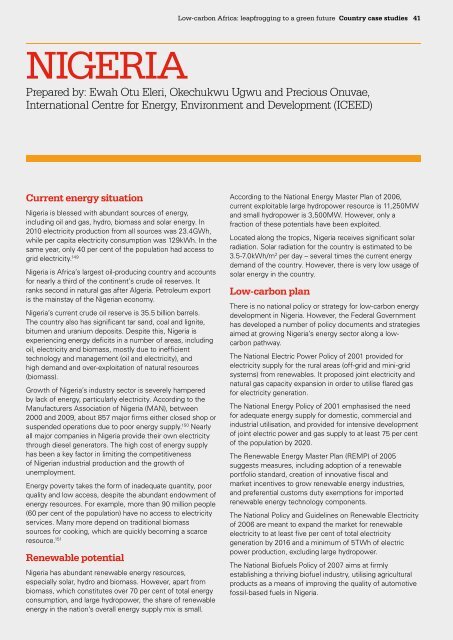Ju8uG
Ju8uG
Ju8uG
You also want an ePaper? Increase the reach of your titles
YUMPU automatically turns print PDFs into web optimized ePapers that Google loves.
Low-carbon Africa: leapfrogging to a green future Country case studies<br />
41<br />
Nigeria<br />
Prepared by: Ewah Otu Eleri, Okechukwu Ugwu and Precious Onuvae,<br />
International Centre for Energy, Environment and Development (ICEED)<br />
Current energy situation<br />
Nigeria is blessed with abundant sources of energy,<br />
including oil and gas, hydro, biomass and solar energy. In<br />
2010 electricity production from all sources was 23.4GWh,<br />
while per capita electricity consumption was 129kWh. In the<br />
same year, only 40 per cent of the population had access to<br />
grid electricity. 149<br />
Nigeria is Africa’s largest oil-producing country and accounts<br />
for nearly a third of the continent’s crude oil reserves. It<br />
ranks second in natural gas after Algeria. Petroleum export<br />
is the mainstay of the Nigerian economy.<br />
Nigeria’s current crude oil reserve is 35.5 billion barrels.<br />
The country also has significant tar sand, coal and lignite,<br />
bitumen and uranium deposits. Despite this, Nigeria is<br />
experiencing energy deficits in a number of areas, including<br />
oil, electricity and biomass, mostly due to inefficient<br />
technology and management (oil and electricity), and<br />
high demand and over-exploitation of natural resources<br />
(biomass).<br />
Growth of Nigeria’s industry sector is severely hampered<br />
by lack of energy, particularly electricity. According to the<br />
Manufacturers Association of Nigeria (MAN), between<br />
2000 and 2009, about 857 major firms either closed shop or<br />
suspended operations due to poor energy supply. 150 Nearly<br />
all major companies in Nigeria provide their own electricity<br />
through diesel generators. The high cost of energy supply<br />
has been a key factor in limiting the competitiveness<br />
of Nigerian industrial production and the growth of<br />
unemployment.<br />
Energy poverty takes the form of inadequate quantity, poor<br />
quality and low access, despite the abundant endowment of<br />
energy resources. For example, more than 90 million people<br />
(60 per cent of the population) have no access to electricity<br />
services. Many more depend on traditional biomass<br />
sources for cooking, which are quickly becoming a scarce<br />
resource. 151<br />
Renewable potential<br />
Nigeria has abundant renewable energy resources,<br />
especially solar, hydro and biomass. However, apart from<br />
biomass, which constitutes over 70 per cent of total energy<br />
consumption, and large hydropower, the share of renewable<br />
energy in the nation’s overall energy supply mix is small.<br />
According to the National Energy Master Plan of 2006,<br />
current exploitable large hydropower resource is 11,250MW<br />
and small hydropower is 3,500MW. However, only a<br />
fraction of these potentials have been exploited.<br />
Located along the tropics, Nigeria receives significant solar<br />
radiation. Solar radiation for the country is estimated to be<br />
3.5-7.0kWh/m 2 per day – several times the current energy<br />
demand of the country. However, there is very low usage of<br />
solar energy in the country.<br />
Low-carbon plan<br />
There is no national policy or strategy for low-carbon energy<br />
development in Nigeria. However, the Federal Government<br />
has developed a number of policy documents and strategies<br />
aimed at growing Nigeria’s energy sector along a lowcarbon<br />
pathway.<br />
The National Electric Power Policy of 2001 provided for<br />
electricity supply for the rural areas (off-grid and mini-grid<br />
systems) from renewables. It proposed joint electricity and<br />
natural gas capacity expansion in order to utilise flared gas<br />
for electricity generation.<br />
The National Energy Policy of 2001 emphasised the need<br />
for adequate energy supply for domestic, commercial and<br />
industrial utilisation, and provided for intensive development<br />
of joint electric power and gas supply to at least 75 per cent<br />
of the population by 2020.<br />
The Renewable Energy Master Plan (REMP) of 2005<br />
suggests measures, including adoption of a renewable<br />
portfolio standard, creation of innovative fiscal and<br />
market incentives to grow renewable energy industries,<br />
and preferential customs duty exemptions for imported<br />
renewable energy technology components.<br />
The National Policy and Guidelines on Renewable Electricity<br />
of 2006 are meant to expand the market for renewable<br />
electricity to at least five per cent of total electricity<br />
generation by 2016 and a minimum of 5TWh of electric<br />
power production, excluding large hydropower.<br />
The National Biofuels Policy of 2007 aims at firmly<br />
establishing a thriving biofuel industry, utilising agricultural<br />
products as a means of improving the quality of automotive<br />
fossil-based fuels in Nigeria.


